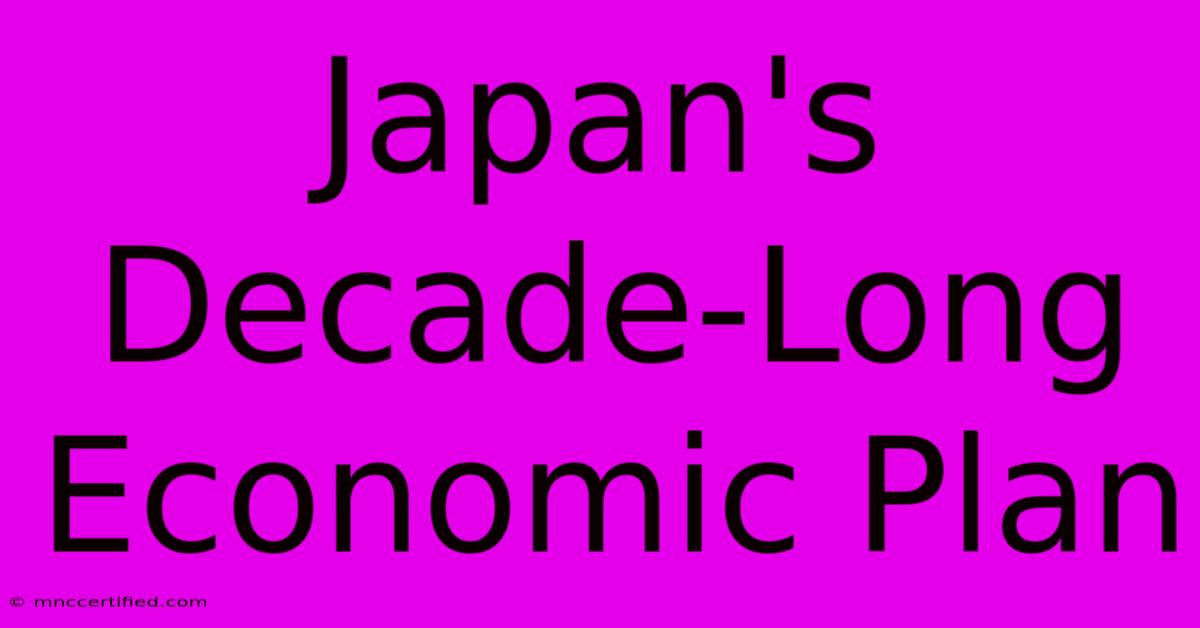Japan's Decade-Long Economic Plan

Table of Contents
Japan's Decade-Long Economic Plan: A Deep Dive into Abenomics and Beyond
Japan's economy has faced significant challenges over the past few decades, grappling with deflation, a shrinking population, and sluggish growth. To address these issues, the country has embarked on various economic strategies, most notably, the ambitious decade-long plan often associated with "Abenomics." This article delves deep into the specifics of this plan, its successes, failures, and the current economic landscape of Japan.
Understanding Abenomics: The Three Arrows
Abenomics, the economic policy framework implemented under former Prime Minister Shinzo Abe, comprised three main pillars:
1. Monetary Policy: Aggressive Quantitative and Qualitative Easing (QQE)
This involved the Bank of Japan (BOJ) aggressively increasing the monetary base through large-scale asset purchases, aiming to achieve a 2% inflation target. The goal was to jolt the economy out of deflation and encourage spending and investment. While initially successful in weakening the Yen and boosting the stock market, achieving sustained inflation proved challenging.
2. Fiscal Policy: Expansionary Government Spending
This involved significant government spending on infrastructure projects, aimed at stimulating economic activity and boosting demand. Public works projects were a key component, but concerns arose regarding the sustainability of such high levels of government debt.
3. Structural Reforms: Deregulation and Labor Market Flexibility
This aspect focused on improving the business environment through deregulation, increasing labor market flexibility, and promoting competition. The goal was to boost productivity and long-term economic growth. While some progress was made in specific sectors, significant structural reforms proved difficult to implement, hampered by entrenched interests and bureaucratic inertia.
Assessing the Successes and Failures of Abenomics
Abenomics achieved some notable successes:
- Yen Depreciation: The weaker Yen boosted exports and benefited export-oriented industries.
- Stock Market Rally: The Nikkei 225 index experienced a significant rise during the early years of Abenomics.
- Reduced Unemployment: Unemployment rates fell to historically low levels.
However, Abenomics also faced significant setbacks:
- Inflation Target Unmet: Despite aggressive monetary easing, the BOJ consistently failed to achieve its 2% inflation target.
- Rising Government Debt: Increased government spending led to a further increase in Japan's already high national debt.
- Slow Wage Growth: Wage growth remained stagnant, hindering consumer spending and overall economic growth.
- Limited Structural Reforms: Progress on structural reforms proved slow and incomplete.
Beyond Abenomics: Japan's Current Economic Strategies
Subsequent governments have continued to grapple with Japan's economic challenges, building upon some aspects of Abenomics while also pursuing new strategies. This includes:
- Focus on Digitalization: Investing heavily in digital infrastructure and technology to enhance productivity and create new economic opportunities.
- Green Growth Initiatives: Promoting renewable energy and sustainable technologies to address climate change while stimulating economic activity.
- Tourism Promotion: Boosting inbound tourism to stimulate economic growth, particularly in regional areas.
- Addressing Demographic Challenges: Implementing policies to address Japan's aging population and shrinking workforce, including immigration reforms and measures to encourage higher birth rates.
The Future of Japan's Economy
Japan's economic future remains uncertain. While the country boasts a highly skilled workforce and technological innovation, overcoming challenges such as an aging population, high national debt, and deflationary pressures remains crucial. The success of future economic strategies will depend on the ability of the government to implement bold reforms, foster innovation, and adapt to the changing global economic landscape. Further attention needs to be paid to sustainable growth, moving beyond short-term stimulus packages towards long-term structural changes that promote inclusive prosperity. The ongoing effects of global economic uncertainty, supply chain disruptions, and geopolitical instability will also play a significant role in shaping Japan's economic trajectory.
Keywords: Japan, Abenomics, Japanese economy, economic policy, deflation, inflation, monetary policy, fiscal policy, structural reforms, quantitative easing, government debt, economic growth, demographic challenges, sustainable growth, BOJ, Nikkei 225, Yen, economic strategy.

Thank you for visiting our website wich cover about Japan's Decade-Long Economic Plan. We hope the information provided has been useful to you. Feel free to contact us if you have any questions or need further assistance. See you next time and dont miss to bookmark.
Featured Posts
-
Conditional Contract In Insurance
Nov 19, 2024
-
North Wales School Closures Snow Update
Nov 19, 2024
-
Radio 2 Schedule Nelson Replaces Mills
Nov 19, 2024
-
Giants Bench Jones 23 M Risk Avoided
Nov 19, 2024
-
American Sports Embrace Trump Dance
Nov 19, 2024